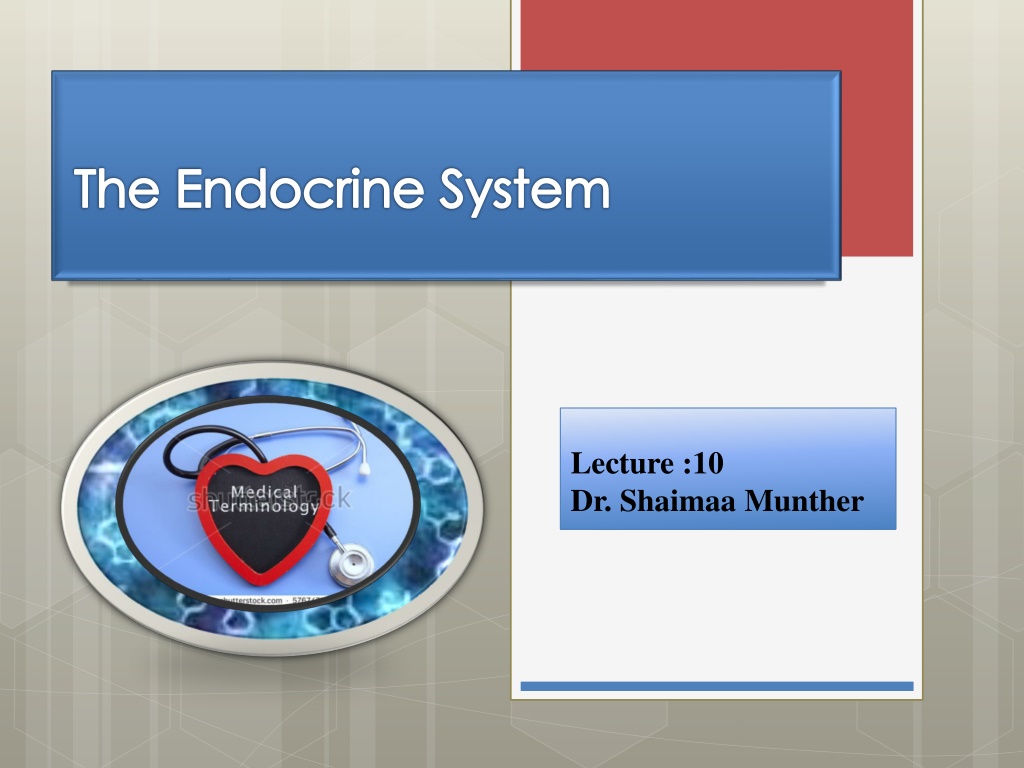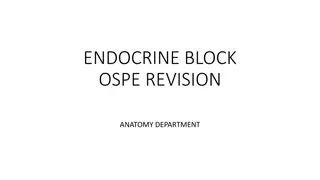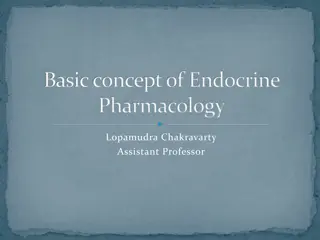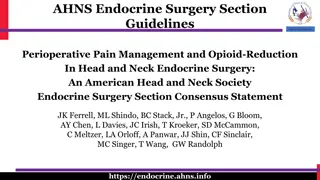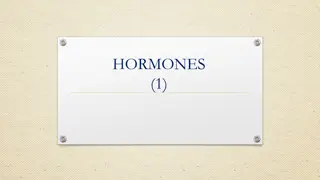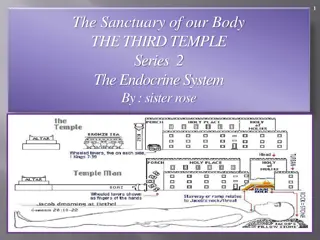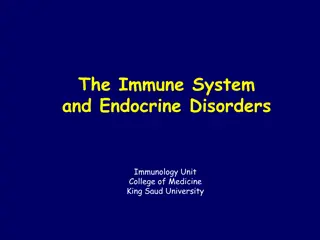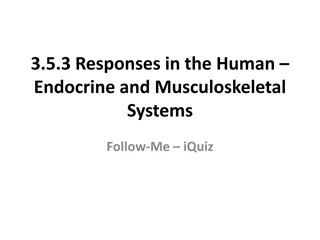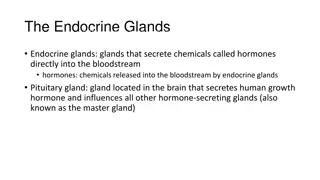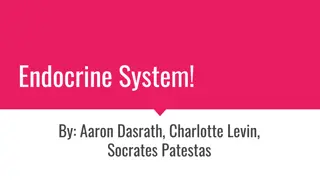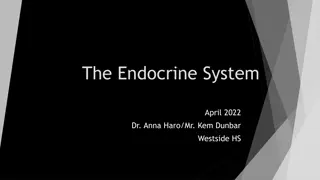Understanding the Endocrine System: Key Concepts and Functions
The endocrine system, consisting of glands that release hormones into the bloodstream, plays a crucial role in regulating various body processes like metabolism, growth, reproduction, and stress response. Key glands include the pituitary, thyroid, pancreas, adrenal, ovaries, and testes, each producing specific hormones essential for bodily functions. Hormones act as messengers, influencing target cells with specific receptors. Understanding the endocrine system is vital for grasping how the body maintains homeostasis and responds to internal and external stimuli.
Download Presentation

Please find below an Image/Link to download the presentation.
The content on the website is provided AS IS for your information and personal use only. It may not be sold, licensed, or shared on other websites without obtaining consent from the author. Download presentation by click this link. If you encounter any issues during the download, it is possible that the publisher has removed the file from their server.
E N D
Presentation Transcript
The Endocrine System Lecture :10 Dr. Shaimaa Munther
The Endocrine System The Endocrine System is a second messenger system of the body Uses chemical messages (hormones) that are released into the blood Hormones control several major processes Reproduction Growth and development Mobilization of body defenses Maintenance of much of homeostasis Regulation of metabolism
The Endocrine System regulates Calcium and glucose levels Water balance Response to stress Growth Reproduction Metabolism by means of the by means of the by means of the by means of the by means of the by means of the Pituitary Testes Thyroid Pancreas Adrenals Ovaries Parathyroids
The Endocrine System Composed of : Glands : Release products to bloodstream directly. Horomones : Products deliver messages to body Target cells : Have specific receptors for specific hormones
Endocrine Glands Section 39-1 Pineal gland The pineal gland releases melatonin, which is involved in rhythmic activities, such as daily sleep-wake cycles. Hypothalamus The hypothalamus makes hormones that control the pituitary gland. In addition, it makes hormones that are stored in the pituitary gland. Thyroid The thyroid produces thyroxine, which regulates metabolism. Pituitary gland The pituitary gland produces hormones that regulate many of the other endocrine glands. Pancreas The pancreas produces insulin and glucagon, which regulate the level of glucose in the blood. Parathyroid glands These four glands release parathyroid hormone, which regulate the level of calcium in the blood. Ovary The ovaries produce estrogen and progesterone. Estrogen is required for the development of secondary sex characteristics and for the development of eggs. Progesterone prepares the uterus for a fertilized egg. Thymus During childhood, the thymus releases thymosin, which stimulates Tcell development. Testis The testes produce testosterone, which is responsible for sperm production and the development of male secondary sex characteristics Adrenal glands The adrenal glands release epinephrine and nonepinephrine, which help the body deal with stress.
Hormone Overview Hormones are produced by specialized cells Cells secrete hormones into extracellular fluids Blood transfers hormones to target sites These hormones regulate the activity of other cells
Hormone Chemistry Protein or Peptide Hormones Protein or peptide hormones constitute the majority of hormones. These are molecules ranging from 3 to 200 amino acid residues. They are synthesized as pre- prohormones and undergo post-translational processing. They are stored in secretory granules before being released by exocytosis . Steroid Hormones Steroid hormones are derived from cholesterol and are synthesized in the adrenal cortex, gonads, and placenta. Vitamin D and its metabolites are also considered steroid hormones. Amino Acid Derived Hormones Amino acid derived hormones are synthesized from the amino acid tyrosine and include the catecholamines norepinephrine, epinephrine, and dopamine; as well as the thyroid hormones, derived from the combination of 2 iodinated tyrosine amino acid residues
Mechanisms of Hormone Action Hormones affect only certain tissues or organs (target cells or organs) Target cells must have specific protein receptors Hormone binding influences the working of the cells
Effects Caused by Hormones Changes in plasma membrane permeability or electrical state Synthesis of proteins, such as enzymes Activation or inactivation of enzymes Stimulation of mitosis
Steroid Hormone Action Diffuse through the plasma membrane of target cells Enter the nucleus Bind to a specific protein within the nucleus Bind to specific sites on the cell s DNA Activate genes that result in synthesis of new proteins. Because steroids work by triggering gene activity, the response is slower than peptide hormones.
steroid hormone (extracellular The hormone binds to a receptor in the nucleus or to a receptor in the cytoplasm that carries it into the nucleus 2 fluid) The hormone receptor complex binds to DNA and causes RNA polymerase to bind to a nearby promoter site for a specific gene 3 1 A steroid hormone diffuses through the plasma membrane DNA plasma membrane hormone receptor ribosome RNA polymerase 5 The mRNA leaves the nucleus, then attaches to a ribosome and directs the synthesis of a specific protein 4 RNA polymerase catalyzes the transcription of DNA into messenger RNA (mRNA) mRNA product gene new protein nuclear envelope (cytoplasm) (nucleus) Steroid Hormone Action
Peptide Hormones Peptide hormones do not enter the cell directly. These hormones bind to receptor proteins in the cell membrane. When the hormone binds with the receptor protein, a secondary messenger molecule initiates the cell response. Because peptide hormones are water soluble, they often produce fast responses.
peptide or amino acid-derived hormone (first messenger) Hormone receptor binding activates an enzyme that catalyzes the synthesis of a second messenger, such as cyclic AMP 2 The hormone binds to a receptor on the plasma membrane of a target cell 1 cyclic AMP- synthesizing enzyme (cytoplasm) (extracellular ATP fluid) active enzyme receptor product cyclic AMP (second messenger) The activated enzymes catalyze specific reactions 4 plasma membrane inactive enzyme 3 reactant The second nuclear envelope messenger activates other enzymes (nucleus) Peptide Hormone Action
HORMONES CAN BE CLASSIFIED IN SEVERAL WAYS Hormones can be classified according to: Chemical composition Solubility properties Location of receptors The nature of the signal used to mediate hormonal action within the cell. A classification based on the last two properties is illustrated in the following slides with illustration to the general features of each group .
Classification of hormones by Location of receptors Group 1 Hormones:
Classification of hormones by Location of receptors Group 2 Hormones:
Classification of hormones by Location of receptors Group 2 Hormones:
Classification of hormones by Location of receptors Group 2 Hormones:
GENERAL FEATURE OF HORMONE CLASSES
